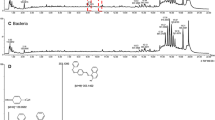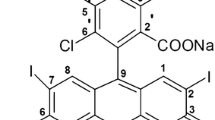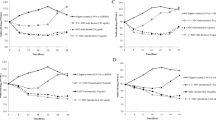Abstract
Azo dyes are widely used in the plastic, paper, cosmetics, food, and pharmaceutical industries. Some metabolites of these dyes are potentially genotoxic. The toxic effects of azo dyes and their potential reduction metabolites on Staphylococcus aureus ATCC BAA 1556 were studied. When the cultures were incubated with 6, 18, and 36 μg/ml of Orange II and Sudan III for 48 h, 76.3, 68.5, and 61.7% of Orange II and 97.8, 93.9, and 75.8% of Sudan III were reduced by the bacterium, respectively. In the presence of 36 μg/ml Sudan III, the cell viability of the bacterium decreased to 61.9% after 48 h of incubation, whereas the cell viability of the control culture without the dye was 71.5%. Moreover, the optical density of the bacterial cultures at 10 h decreased from 0.74 to 0.55, indicating that Sudan III is able to inhibit growth of the bacterium. However, Orange II had no significant effects on either cell growth or cell viability of the bacterium at the tested concentrations. 1-Amino-2-naphthol, a metabolite common to Orange II and Sudan III, was capable of inhibiting cell growth of the bacterium at 1 μg/ml and completely stopped bacterial cell growth at 24–48 μg/ml. On the other hand, the other metabolites of Orange II and Sudan III, namely sulfanilic acid, p-phenylenediamine, and aniline, showed no significant effects on cell growth. p-Phenylenediamine exhibited a synergistic effect with 1-amino-2-naphthol on cell growth inhibition. All of the dye metabolites had no significant effects on cell viability of the bacterium.



Similar content being viewed by others
References
Abram FSH, Sims IR (1982) The toxicity of aniline to rainbow trout. Water Res 16:1309–1312
An Y, Jiang L, Cao J, Geng C, Zhong L (2007) Sudan I induces genotoxic effects and oxidative DNA damage in HepG2 cells. Mutat Res 627:164–170
Ben Mansour H, Corroler D, Barillier D, Ghedira K, Chekir L, Mosrati R (2007) Evaluation of genotoxicity and pro-oxidant effect of the azo dyes: acids yellow 17, violet 7 and orange 52, and of their degradation products by Pseudomonas putida mt-2. Food Chem Toxicol 45:1670–1677
Bomhard EM, Herbold BA (2005) Genotoxic activities of aniline and its metabolites and their relationship to the carcinogenicity of aniline in the spleen of rats. Crit Rev Toxicol 35:783–835
Calbiani F, Careri M, Elviri L, Mangia A, Pistara L, Zagnoni I (2004) Development and in-house validation of a liquid chromatography-electrospray-tandem mass spectrometry method for the simultaneous determination of Sudan I, Sudan II, Sudan III and Sudan IV in hot chilli products. J Chromatogr A 1042:123–130
Cerniglia CE, Zhuo Z, Manning BW, Federle TW, Heflich RH (1986) Mutagenic activation of the benzidine-based dye direct black 38 by human intestinal microflora. Mutat Res 175:11–16
Chambers HF, Deleo FR (2009) Waves of resistance: Staphylococcus aureus in the antibiotic era. Nat Rev Microbiol 7:629–641
Chen H, Feng J, Kweon O, Xu H, Cerniglia C (2010) Identification and molecular characterization of a novel flavin-free NADPH preferred azoreductase encoded by azoB in Pigmentiphaga kullae K24. BMC Biochemistry 11:13
Chen H, Hopper SL, Cerniglia CE (2005) Biochemical and molecular characterization of an azoreductase from Staphylococcus aureus, a tetrameric NADPH-dependent flavoprotein. Microbiology 151:1433–1441
Chen H, Xu H, Heinze TM, Cerniglia CE (2009) Decolorization of water and oil-soluble azo dyes by Lactobacillus acidophilus and Lactobacillus fermentum. J Ind Microbiol Biotechnol 36:1459–1466
Chen H, Xu H, Kweon O, Chen S, Cerniglia CE (2008) Functional role of Trp-105 of Enterococcus faecalis azoreductase (AzoA) as resolved by structural and mutational analysis. Microbiology 154:2659–2667
Chen KC, Huang WT, Wu JY, Houng JY (1999) Microbial decolorization of azo dyes by Proteus mirabilis. J Ind Microbiol Biotechnol 23:686–690
Chung KT (1983) The significance of azo-reduction in the mutagenesis and carcinogenesis of azo dyes. Mutat Res 114:269–281
Chung KT, Fulk GE, Egan M (1978) Reduction of azo dyes by intestinal anaerobes. Appl Environ Microbiol 35:558–562
Chung KT, Stevens SE Jr, Cerniglia CE (1992) The reduction of azo dyes by the intestinal microflora. Crit Rev Microbiol 18:175–190
Cogen AL, Nizet V, Gallo RL (2008) Skin microbiota: a source of disease or defence? Br J Dermatol 158:442–455
Daniels NA, MacKinnon L, Rowe SM, Bean NH, Griffin PM, Mead PS (2002) Foodborne disease outbreaks in United States schools. Pediatr Infect Dis J 21:623–628
Elisangela F, Andrea Z, Fabio DG, Menezes Cristiano R, Regina DL, Artur C-P (2009) Biodegradation of textile azo dyes by a facultative Staphylococcus arlettae strain VN-11 using a sequential microaerophilic/aerobic process. Int Biodeter Biodegr 63:280–288
Fassina G, Abbondandolo A, Mariani L, Taningher M, Parodi S (1990) Mutagenicity in V79 cells does not correlate with carcinogenity in small rodents for 12 aromatic amines. J Toxicol Environ Health 29:109–130
Feng J, Heinze TM, Xu H, Cerniglia CE, Chen H (2010) Evidence for significantly enhancing reduction of Azo dyes in Escherichia coli by expressed cytoplasmic Azoreductase (AzoA) of Enterococcus faecalis. Protein Pept Lett 17:578–584
Gao Z, Tseng CH, Pei Z, Blaser MJ (2007) Molecular analysis of human forearm superficial skin bacterial biota. Proc Natl Acad Sci U S A 104:2927–2932
Garrigue JL, Ballantyne M, Kumaravel T, Lloyd M, Nohynek GJ, Kirkland D, Toutain H (2006) In vitro genotoxicity of para-phenylenediamine and its N-monoacetyl or N,N′-diacetyl metabolites. Mutat Res 608:58–71
Gottlieb A, Shaw C, Smith A, Wheatley A, Forsythe S (2003) The toxicity of textile reactive azo dyes after hydrolysis and decolourisation. J Biotechnol 101:49–56
Hou M, Li F, Liu X, Wang X, Wan H (2007) The effect of substituent groups on the reductive degradation of azo dyes by zerovalent iron. J Hazard Mater 145:305–314
Ito K, Nakanishi M, Lee WC, Sasaki H, Zenno S, Saigo K, Kitade Y, Tanokura M (2006) Three-dimensional structure of AzoR from Escherichia coli. An oxidereductase conserved in microorganisms. J Biol Chem 281:20567–20576
Ito K, Nakanishi M, Lee WC, Zhi Y, Sasaki H, Zenno S, Saigo K, Kitade Y, Tanokura M (2008) Expansion of substrate specificity and catalytic mechanism of azoreductase by X-ray crystallography and site-directed mutagenesis. J Biol Chem 283:13889–13896
Joshi T, Iyengar L, Singh K, Garg S (2008) Isolation, identification and application of novel bacterial consortium TJ-1 for the decolourization of structurally different azo dyes. Bioresour Technol 99:7115–7121
Khan MF, Wu X, Kaphalia BS, Boor PJ, Ansari GAS (1997) Acute hematopoietic toxicity of aniline in rats. Toxicol Lett 92:31–37
Kozuka I, Goh CL, Doi T, Yioshikawa K (1988) Sudan I as a cause of pigmented contact dermatitis in “kumkum” (an Indian cosmetic). Ann Acad Med Singapore 17:492–494
Levine WG (1991) Metabolism of azo dyes: implication for detoxication and activation. Drug Metab Rev 23:253–309
Li L, Gao HW, Ren JR, Chen L, Li YC, Zhao JF, Zhao HP, Yuan Y (2007) Binding of Sudan II and IV to lecithin liposomes and E. coli membranes: insights into the toxicity of hydrophobic azo dyes. BMC Struct Biol 7:16
Liger D, Graille M, Zhou CZ, Leulliot N, Quevillon-Cheruel S, Blondeau K, Janin J, van Tilbeurgh H (2004) Crystal structure and functional characterization of yeast YLR011wp, an enzyme with NAD(P)H-FMN and ferric iron reductase activities. J Biol Chem 279:34890–34897
Lindsay JA, Holden MT (2004) Staphylococcus aureus: superbug, super genome? Trends Microbiol 12:378–385
Liu ZJ, Chen H, Shaw N, Hopper SL, Chen L, Chen S, Cerniglia CE, Wang BC (2007) Crystal structure of an aerobic FMN-dependent azoreductase (AzoA) from Enterococcus faecalis. Arch Biochem Biophys 463:68–77
Macwana SR, Punj S, Cooper J, Schwenk E, John GH (2009) Identification and Isolation of an Azoreductase from Enterococcus faecium. Curr Issues Mol Biol 12:43–48
Mansour HB, Mosrati R, Corroler D, Ghedira K, Barillier D, Chekir-Ghedira L (2009) Mutagenicity and genotoxicity of acid yellow 17 and its biodegradation products. Drug Chem Toxicol 32:222–229
Marmion DM (1991) Handbook of US colorants: foods, drugs, cosmetics, and medical devices, 3rd edn. Wiley-Interscience, London
Massey RC, Horsburgh MJ, Lina G, Hook M, Recker M (2006) The evolution and maintenance of virulence in Staphylococcus aureus: a role for host-to-host transmission? Nat Rev Microbiol 4:953–958
Morokutti A, Lyskowski A, Sollner S, Pointner E, Fitzpatrick TB, Kratky C, Gruber K, Macheroux P (2005) Structure and function of YcnD from Bacillus subtilis, a flavin-containing oxidoreductase. Biochemistry 44:13724–13733
Muzzall JM, Cook WL (1979) Mutagenicity test of dyes used in cosmetics with the Salmonella/mammalian-microsome test. Mutat Res 67:1–8
Ng TW, Cai Q, Wong C-K, Chow AT, Wong P-K (2010) Simultaneous chromate reduction and azo dye decolourization by Brevibacterium casei: azo dye as electron donor for chromate reduction. J Hazard Mater 182:792–800
Pereira L, Coelho AV, Viegas CA, Santos MM, Robalo MP, Martins LO (2009) Enzymatic biotransformation of the azo dye Sudan Orange G with bacterial CotA-laccase. J Biotechnol 139:68–77
Platzek T, Lang C, Grohmann G, Gi US, Baltes W (1999) Formation of a carcinogenic aromatic amine from an azo dye by human skin bacteria in vitro. Hum Exp Toxicol 18:552–559
Ren JR, Zhao HP, Song C, Wang SL, Li L, Xu YT, Gao HW (2010) Comparative transmembrane transports of four typical lipophilic organic chemicals. Bioresour Technol 101:8632–8638
Ryan A, Laurieri N, Westwood I, Wang CJ, Lowe E, Sim E (2010) A novel mechanism for azoreduction. J Mol Biol 400:24–37
Stingley RL, Zou W, Heinze TM, Chen HZ, Cerniglia CE (2010) Metabolism of azo dyes by human skin microbiota. J Med Microbiol 59:108–114
Wang CJ, Hagemeier C, Rahman N, Lowe E, Noble M, Coughtrie M, Sim E, Westwood I (2007) Molecular cloning, characterisation and ligand-bound structure of an azoreductase from Pseudomonas aeruginosa. J Mol Biol 373:1213–1228
Wang CJ, Laurieri N, Abuhammad A, Lowe E, Westwood I, Ryan A, Sim E (2010) Role of tyrosine 131 in the active site of paAzoR1, an azoreductase with specificity for the inflammatory bowel disease prodrug balsalazide. Acta Crystallogr Sect F Struct Biol Cryst Commun 66:2–7
Xu H, Heinze TM, Chen S, Cerniglia CE, Chen H (2007) Anaerobic metabolism of 1-amino-2-naphthol-based azo dyes (Sudan dyes) by human intestinal microflora. Appl Environ Microbiol 73:7759–7762
Xu H, Heinze TM, Paine DD, Cerniglia CE, Chen H (2010) Sudan azo dyes and Para Red degradation by prevalent bacteria of the human gastrointestinal tract. Anaerobe 16:114–119
Zhao X, Lu Y, Phillips DR, Hwang HM, Hardin IR (2007) Study of biodegradation products from azo dyes in fungal degradation by capillary electrophoresis/electrospray mass spectrometry. J Chromatogr A 1159:217–224
Acknowledgments
We thank Drs. Huanli Liu, Rajesh Nayak, and Robin Stingley for their critical review of the manuscript, Dr. Mark Hart for strain ATCC BAA 1556, and Ohgew Kweon for helpful discussions. This study was funded by the Office of Women’s Health and the National Center for Toxicological Research, United States Food and Drug Administration, and supported in part by appointments (HP and JF) to the Postgraduate Research Fellowship Program by the Oak Ridge Institute for Science and Education through an interagency agreement between the US Department of Energy and the US Food and Drug Administration. The views presented in this article do not necessarily reflect those of the Food and Drug Administration.
Author information
Authors and Affiliations
Corresponding author
Rights and permissions
About this article
Cite this article
Pan, H., Feng, J., Cerniglia, C.E. et al. Effects of Orange II and Sudan III azo dyes and their metabolites on Staphylococcus aureus . J Ind Microbiol Biotechnol 38, 1729–1738 (2011). https://doi.org/10.1007/s10295-011-0962-3
Received:
Accepted:
Published:
Issue Date:
DOI: https://doi.org/10.1007/s10295-011-0962-3




